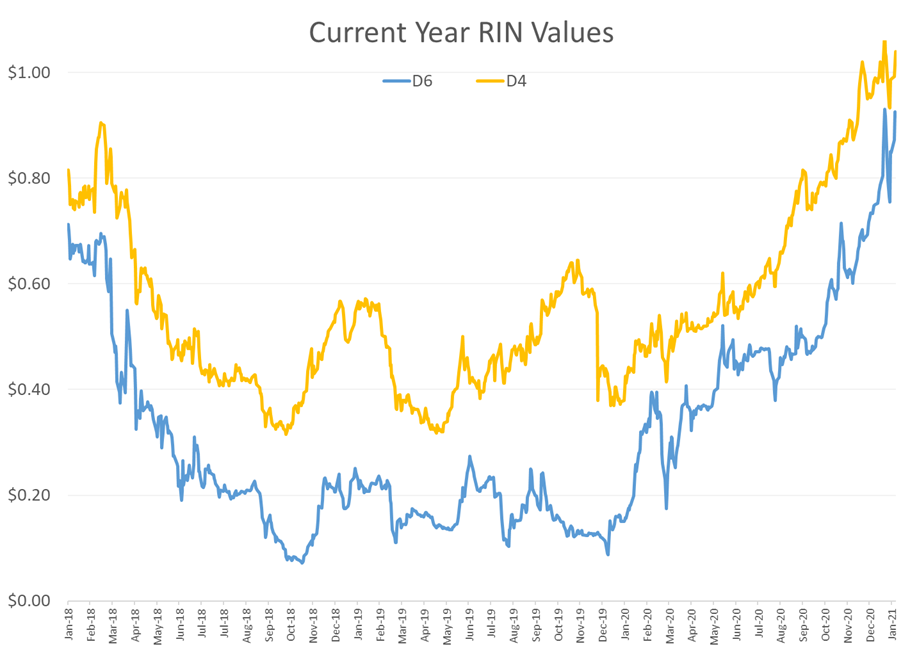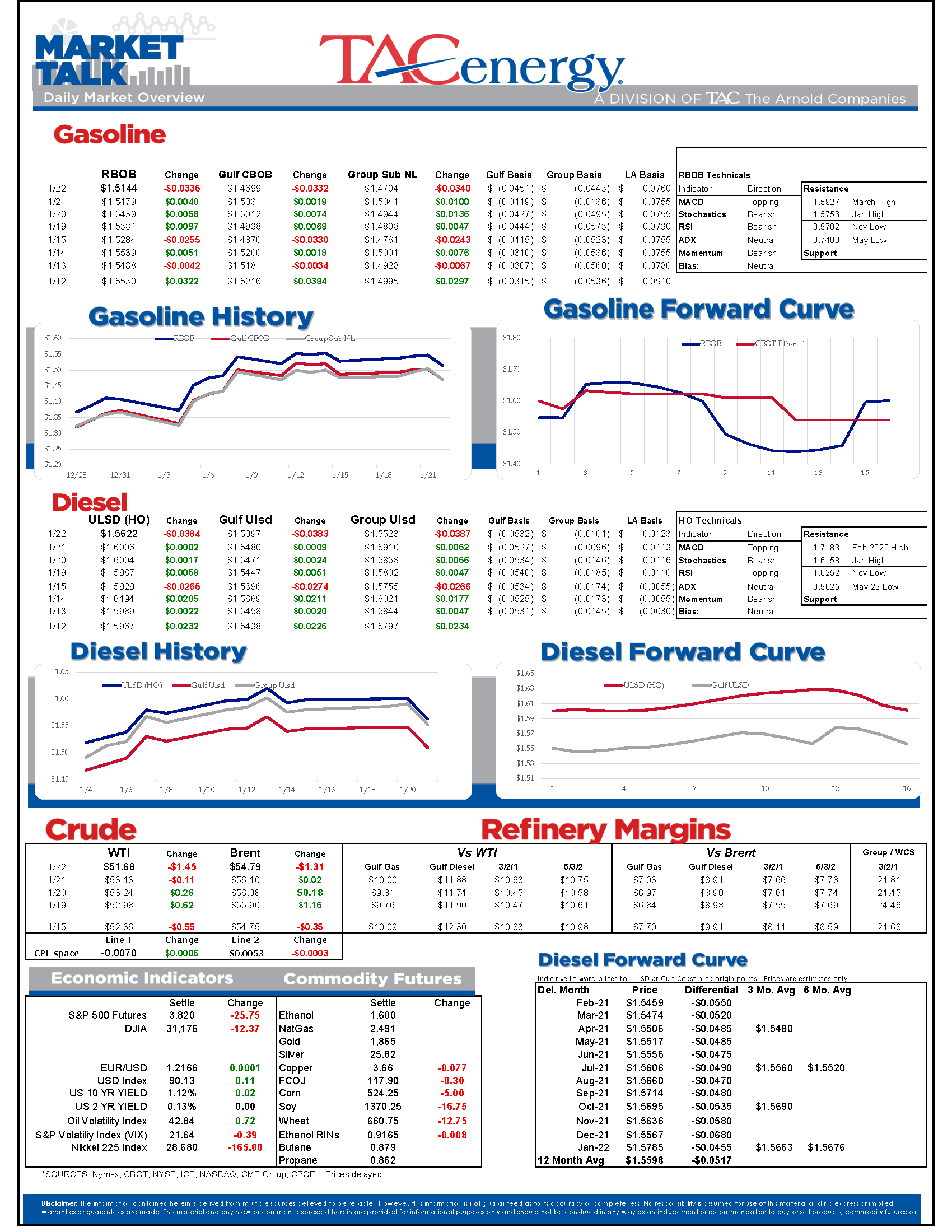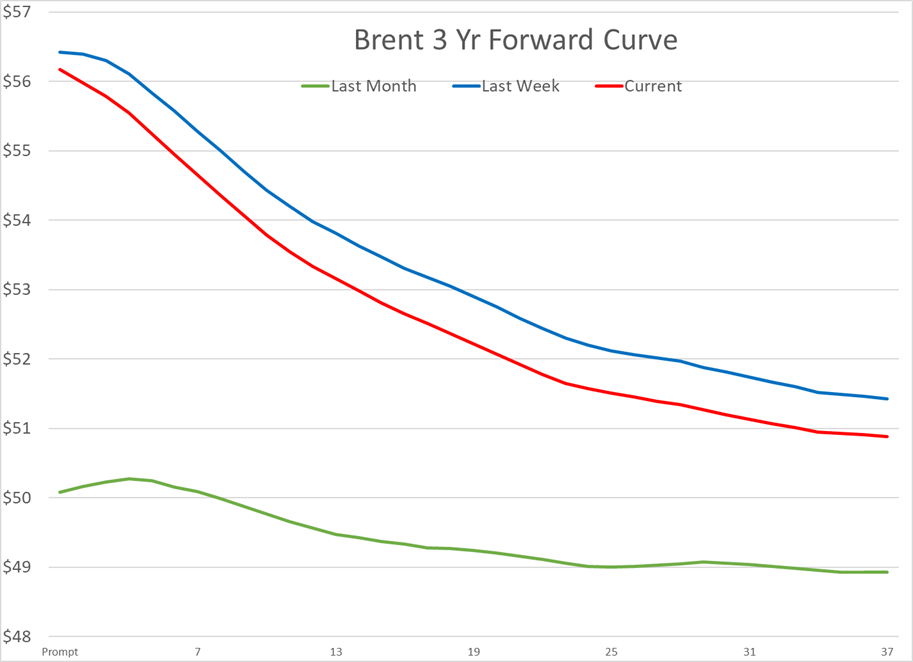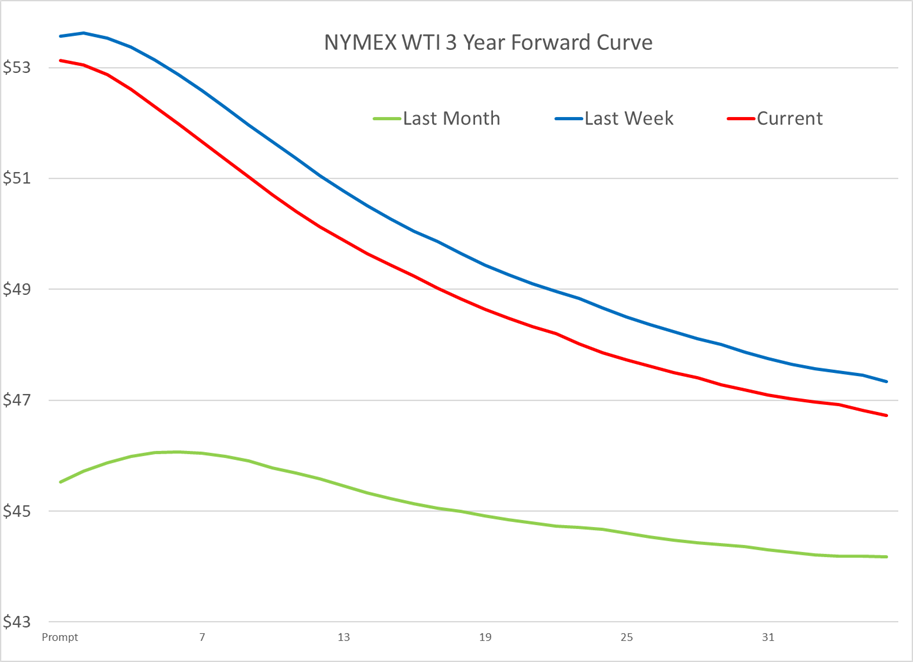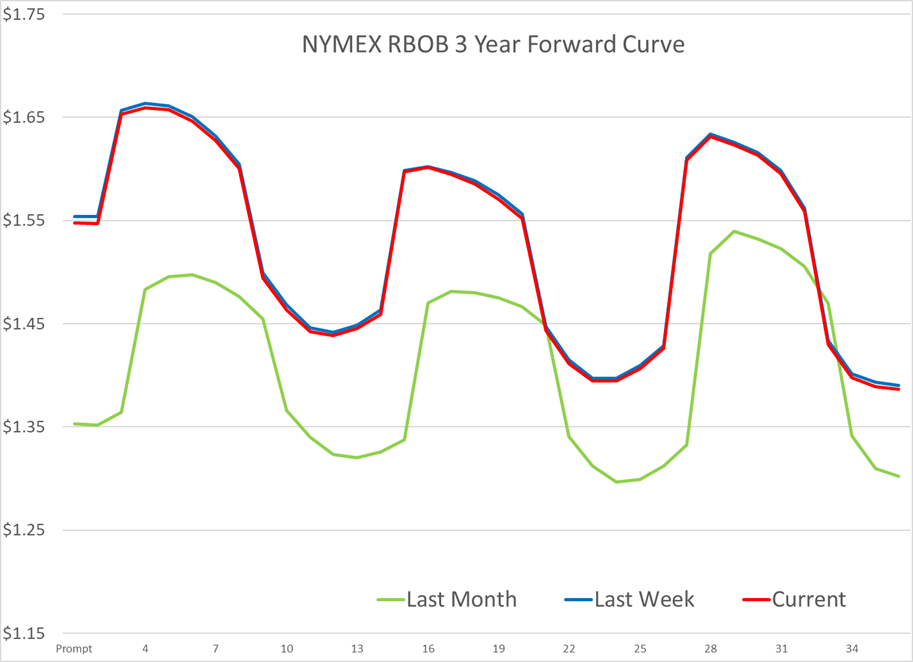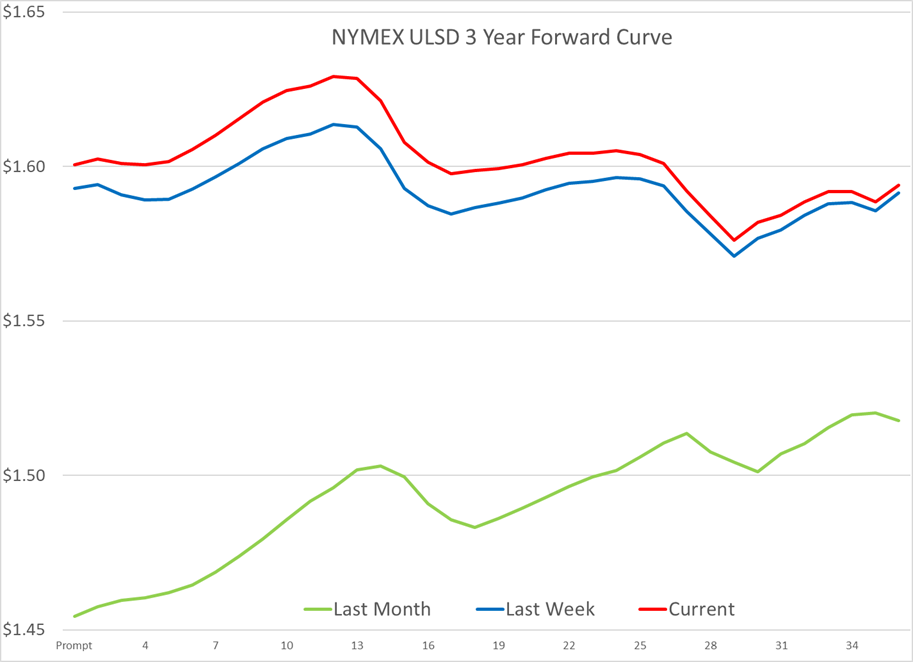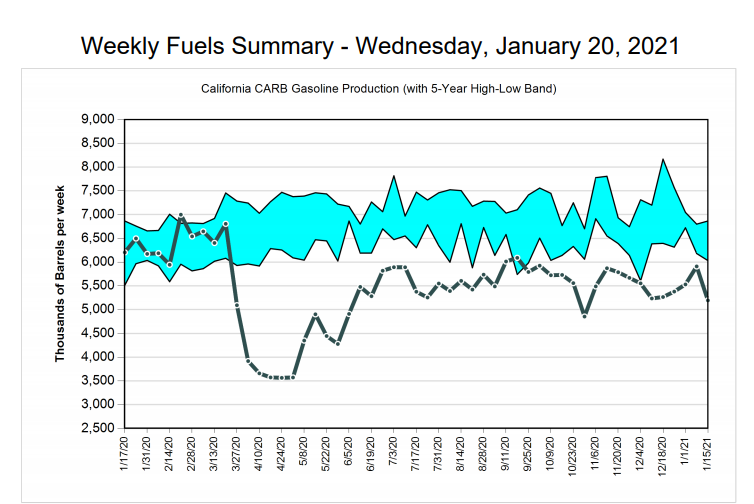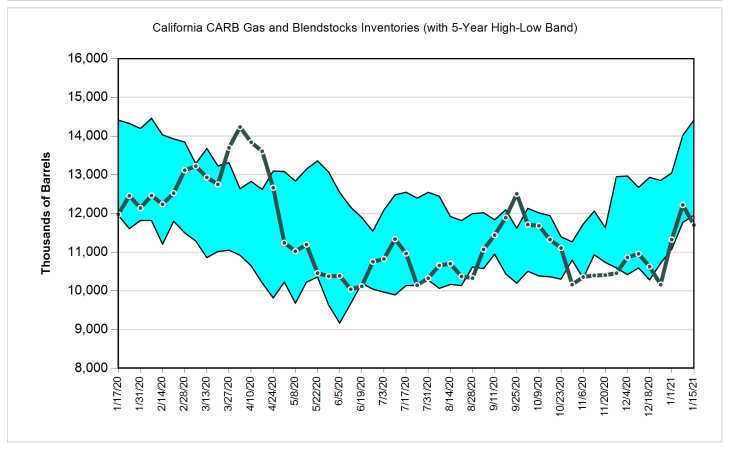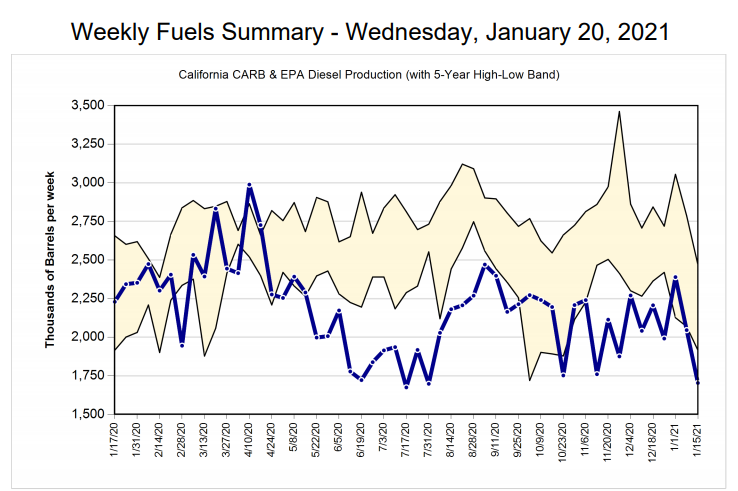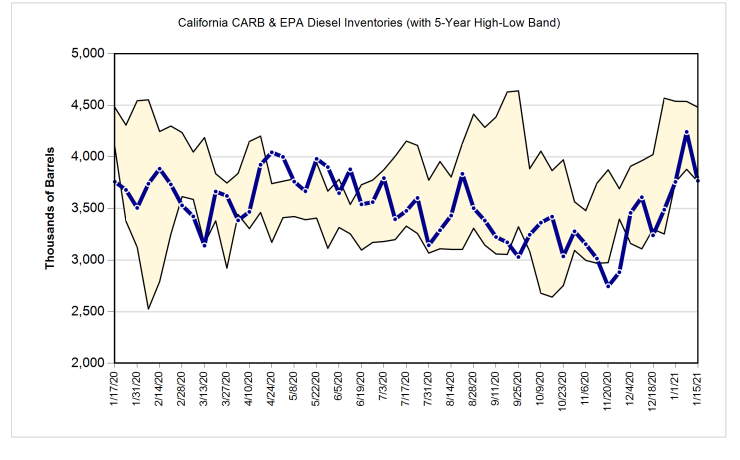A Pivotal Week On The Charts

Energy prices faced their biggest selloff since the first trading day of January overnight as rising COVID case counts in China and spreading lockdowns across Europe appear to be hitting demand, dampening the bullish enthusiasm that’s gripped the market since early November. This next week looks like it will be pivotal on the charts, as we’re seeing a rounding top for most of the petroleum contracts that have not yet broken below the bullish trend lines. If prices can manage to recover today, there’s still a case to be made that the bulls are in control. If they dip much further, the charts will favor another 10 cents of downside for products in short order.
The charts below show the dramatic change in the forward curves for oil and diesel prices over the past month as the price rally has pushed prices into backwardation. That change could be a double-edged sword for flat prices, as it takes the storage buyers out of the market, which also helps to encourage reductions in inventory levels. That strength in the curve also seems contradictory to the demand patterns playing out across Europe, Asia and the U.S., as new lockdown measures are hampering demand all over. The Saudi’s decision to cut one million barrels/day of oil production was enough to override that demand drop in January, but it’s looking like something else will be necessary to prevent a larger selloff now.
The DOE’s weekly inventory report is due out at 11 a.m. Eastern today, after the rare two-day delay this week caused by the inauguration. In normal years, we expect to see demand increasing sharply in the back-half of January as the country shakes off the holiday hangover effect and gets back to work. This year it seems like that bounce may have to wait until the vaccine rollout starts outpacing the impacts of lockdowns.
Oddly enough, California’s energy commission didn’t take Wednesday off like the DOE did, and reported that the state’s production of gasoline and diesel plummeted to multi-month lows (see charts below). The sharp decrease in refinery output appears to be in response to swelling inventory levels over the previous two weeks as the demand has dropped sharply due to the ongoing COVID fallout.
More bad news from refiners: Irving Oil announced another layoff, this time for 60 employees at its St. John refinery, a major fuel supplier to the U.S. East Coast, due to “the collapse in demand for motor fuels.” Meanwhile, nearly 200 union workers at the Marathon refinery in St. Paul Park, MN walked off the job last night, apparently waiting for the coldest time of the year to start picketing. The refinery is reportedly continuing operations as normal, and even if it wasn’t, given its location and size isn’t likely to create much of an impact on either the Group 3 or Chicago basis markets this time of year.
The RIN market continues to rally, even as grain prices have pulled back this week, as last minute moves by the outgoing EPA administration regarding small refinery waivers, and emissions permitting, were postponed by federal court rulings, which should allow enough time for the new administration to nullify them.
Click here to download a PDF of today's TACenergy Market Talk.
Latest Posts
Week 16 - US DOE Inventory Recap
Energy Markets Trading Quietly In The Red As Ethanol Prices Rally To Five-Month High
The Struggle For Renewable Producers Continues As A Rapid Influx Of Supply And Crashing Credit Prices Make Biodiesel
After Years Of Backwardation, Diesel Prices Have Slipped Into Contango Over The Past Week
Social Media
News & Views
View All
Week 16 - US DOE Inventory Recap

Energy Markets Trading Quietly In The Red As Ethanol Prices Rally To Five-Month High
Energy markets are trading quietly in the red to start Wednesday’s session after a healthy bounce Tuesday afternoon suggested the Israel-Iran-linked liquidation had finally run its course.
There are reports of more Ukrainian strikes on Russian energy assets overnight, but the sources are sketchy so far, and the market doesn’t seem to be reacting as if this is legitimate news.
Ethanol prices have rallied to a 5-month high this week as corn and other grain prices have rallied after the latest crop progress update highlighted risks to farmers this year, lower grain export expectations from Ukraine, and the approval of E15 blends this summer despite the fact it pollutes more. The rally in grain and renewables prices has also helped RIN values find a bid after it looked like they were about to test their 4-year lows last week.
The API reported small changes in refined product inventories last week, with gasoline stocks down about 600,000, while distillates were up 724,000. Crude oil inventories increased by 3.2 million barrels according to the industry-group estimates. The DOE’s weekly report is due out at its normal time this morning.
Total reported another upset at its Port Arthur refinery that’s been a frequent flier on the TCEQ alerts since the January deep freeze knocked it offline and damaged multiple operating units. This latest upset seems minor as the un-named unit impacted was returned to normal operations in under an hour. Gulf Coast basis markets have shrugged off most reports of refinery upsets this year as the region remains well supplied, and it’s unlikely we’ll see any impact from this news.
California conversely reacted in a big way to reports of an upset at Chevron’s El Segundo refinery outside of LA, with CARBOB basis values jumping by more than a dime. Energy News Today continued to show its value by reporting the upset before the flaring notice was even reported to area regulators, proving once again it’s ahead of the curve on refinery-related events. Another industry news outlet meanwhile struggled just to remember where the country’s largest diesel seller is located.
Click here to download a PDF of today's TACenergy Market Talk

The Struggle For Renewable Producers Continues As A Rapid Influx Of Supply And Crashing Credit Prices Make Biodiesel
The sigh of relief selloff continues in energy markets Tuesday morning, with gasoline prices now down more than 20 cents in 7 sessions, while diesel prices have dropped 26 cents in the past 12. Crude oil prices are within a few pennies of reaching a 1 month low as a lack of headlines from the world’s hot spots allows some reflection into the state of the world’s spare capacity for both oil and refined products.
Gasoline prices are trading near a 6-week low this morning, but still need to fall about another nickel in order to break the weekly trendline that pushed prices steadily higher since December. If that trend breaks, it will be safer to say that we saw the end of the spring gasoline rally on April 12th for the 2nd year in a row. Last year RBOB futures peaked on April 12 at $2.8943 and bottomed out on May 4th at $2.2500. The high (at this point) for this year was set on April 12th at $2.8516, and the low overnight was $2.6454.
It’s not just energy commodities that are seeing an unwind of the “flight to safety” trade: Gold prices had their biggest selloff in 2 years Monday and continue to point lower today. Just how much money poured into commodities in the weeks leading up to the direct confrontation between Israel and Iran is unclear, but we have seen in year’s past that these unwind-events can create a snowball effect as traders can be forced to sell to cover their margin calls.
Supply > Demand: The EIA this morning highlighted the record setting demand for natural gas in the US last year, which was not nearly enough to offset the glut of supply that forced prices to a record low in February. A shortage of natural gas in Europe was a key driver of the chaotic markets that smashed just about every record in 2022, and an excess of natural gas supply in Europe and the US this year is acting as a buffer, particularly on diesel prices.
The struggle for renewable producers continues as a rapid influx of supply and crashing credit prices make Biodiesel, RD and SAF unprofitable for many. In addition to the plant closures announced in the past 6 months, Vertex Energy reported Monday it’s operating its Renewable Diesel facility in Mobile AL at just 50% of capacity in Q1. The truly scary part for many is that the $1/gallon Blender's tax credit ends this year and is being replaced by the “Clean” Fuel production credit that forces producers to prove their emissions reductions in order to qualify for an increased subsidy. It’s impossible to say at this point how much the net reduction will be for domestic producers, but importers will get nothing, and at current CI values, many biodiesel producers may see their “blend credit” cut by more than half.
Click here to download a PDF of today's TACenergy Market Talk.
